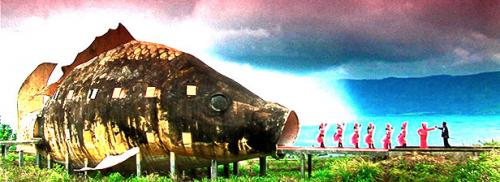
The filmmakers examine a country where death squad leaders are celebrated as heroes, challenging them to reenact their real-life mass-killings in the style of the American movies they love. The hallucinatory result is a cinematic fever dream, an unsettling journey deep into the imaginations of mass-murderers and the shockingly banal regime of corruption and impunity they inhabit.
In mid-October 2013, I had written an article about the movie No Fire Zone which is the true story of war crimes committed at the end of the Sri Lankan civil war in 2009. I was quite motivated, based on the fact that I had read in one newspaper that the Government of Sri Lanka had requested the Government of Nepal to ban three Sri Lankan films, to see No Fire Zone which was showing at the Film SouthAsia (FSA) Festival. No Fire Zone really sickened me and left me wondering how human beings continue to massacre one another.
Being somewhat of a movie buff and having read about “The Act of Killing” I downloaded it to find out more about the horrific history of people. The movie is essentially about evil, a group of thugs, an entire government that is able to sleep at night although they’ve massacred people considered to be “communists” . The movie is surreal, a dream, but yet reality. The following is from the web.
When Sukarno was overthrown by Suharto following the failed coup of the 30 September Movement in 1965, the gangsters Anwar Congo and Adi Zulkadry in Medan (North Sumatra) (the stars of the movie) were promoted from selling black market movie theatre tickets to leading the most notorious death squad in North Sumatra, as part of the Indonesian killings of 1965–66. They also extorted ethnic Chinese locals, killing those who refused to pay. Anwar personally killed approximately 1,000 people, usually by strangling with wire.
Today, Anwar is revered as a founding father of the right-wing paramilitary organization Pemuda Pancasila that grew out of the death squads. The organization is so powerful that its leaders include government ministers, and they are happy to boast about everything from corruption and election rigging to genocide. A regime was founded on crimes against humanity, yet has never been held accountable.
The Indonesian killings of 1965–1966 were an anti-communist purge following a failed coup of the 30 September Movement in Indonesia (also called in Indonesia: the Kudeta). The most widely accepted estimates are that more than 500,000 people were killed. The purge was a pivotal event in the transition to the "New Order"; the Indonesian Communist Party (PKI) was eliminated as a political force, and the upheavals led to the downfall of president Sukarno and the commencement of Suharto's thirty-year presidency.
The failed coup released pent-up communal hatreds which were fanned by the Indonesian Army, which quickly blamed the PKI. Communists were purged from political, social, and military life, and the PKI itself was banned. The massacres began in October 1965, in the weeks following the coup attempt, and reached their peak over the remainder of the year before subsiding in the early months of 1966. They started in the capital, Jakarta, and spread to Central and East Java and, later, Bali. Thousands of local vigilantes and army units killed actual and alleged PKI members. Although killings occurred across Indonesia, the worst were in the PKI strongholds of Central Java, East Java, Bali, and northern Sumatra. It is possible that over one million people were imprisoned at one time or another.
The killings are skipped over in most Indonesian history books and have received little introspection by Indonesians and comparatively little international attention. Satisfactory explanations for the scale and frenzy of the violence have challenged scholars from all ideological perspectives. The possibility of a return to similar upheavals is cited as a factor in the "New Order" administration's political conservatism and tight control of the political system. Vigilance against a perceived communist threat remained a hallmark of Suharto's thirty-year presidency.
A top secret CIA report described the massacre as "one of the worst mass murders of the 20th century."[1]
In some areas, civilian militia knew where to find known Communists and their sympathisers, while in others the Army demanded lists of Communists from village heads.[22] PKI membership was not disguised and most suspects were easily identified within communities.[23] The American Embassy in Jakarta supplied the Indonesian military with lists of up to 5,000 suspected Communists.[24] Although some PKI branches organised resistance and reprisal killings, most went passively to their deaths.[25] Not all victims were PKI members. Often the label "PKI" was used to include anyone to the left of the Indonesian National Party (PNI).[26] In other cases victims were suspected or simply alleged Communists.[10]
Methods of killing included shooting and beheading with Japanese-style samurai swords. Corpses were often thrown into rivers, and at one point officials complained to the Army that the rivers running into the city of Surabaya were clogged with bodies. In areas such as Kediri in East Java, Nahdlatul Ulama youth wing (Ansor) members lined up Communists, cut their throats and disposed of the bodies in rivers.[27] The killings left whole sections of villages empty, and the houses of victims or the interned were looted and often handed over to the military.[26]
Local Chinese were killed in some areas, and their properties looted and burned as a result of anti-Chinese racism on the excuse that Aidit had brought the PKI closer to China.[26] In the predominantly Christian islands of Nusa Tenggara, Christian clergy and teachers suffered at the hands of Muslim youth.[20]
Although there were occasional and isolated flare ups until 1969, the killings largely subsided by March 1966,[28] when either there were no more suspects, or authorities intervened.[29] Solo residents said that exceptionally high flooding in March 1966 of the Solo River, considered mystical by the Javanese, signaled the end of the killings.
There really isn’t much more that I can say except see this movie. When will we ever learn?










Add new comment